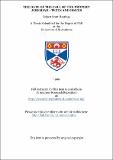The date of the call of the Prophet Jeremiah : texts and issues
Abstract
This dissertation entitled, "The Date of the Call of the Prophet Jeremiah: Texts and Issues," attempts to demonstrate that the most plausible date for the beginning of the prophetic career of Jeremiah is that provided in the tradition itself, i.e. the thirteenth year of Josiah (627). In supporting this, two main topics are addressed. First, the alternative dates which have been forwarded in modern scholarship are examined, and shown to be based upon untenable ideas. Secondly, the various objections which have been proffered against the 627 date are analysed, and the case is made that these objections are invalid. Finally, an attempt is made to explain the message and activity of the prophet within the historical milieu of Judah in the years 627-622. The current study develops this thesis in seven chapters. The first chapter discusses the historical context of the years 640-609, and Josiah's reforms. In chapter two it is argued that the prose sermons should be attributed to Jeremiah, and represent a style of the seventh century. Chapter three demonstrates the implausibility of the alternative dating proposals, while in chapter four it is proposed that the threatened invader of the foe from the north oracles was not originally identified by Jeremiah. The issue of Isaiah and the reforms of Hezekiah as a comparable example is handled in chapter five. Chapter six addresses Jeremiah's attitude toward the cultic reforms of Josiah and the appearance of Deuteronomy in 622, and it is shown that the prophet did speak out in support of the newly published law book. Finally in chapter seven, Jeremiah's relative withdrawal from public activity during the period 622-609 is demonstrated, and the prophet's message is explained in light of the setting of the years 627-622.
Type
Thesis, PhD Doctor of Philosophy
Collections
Items in the St Andrews Research Repository are protected by copyright, with all rights reserved, unless otherwise indicated.

